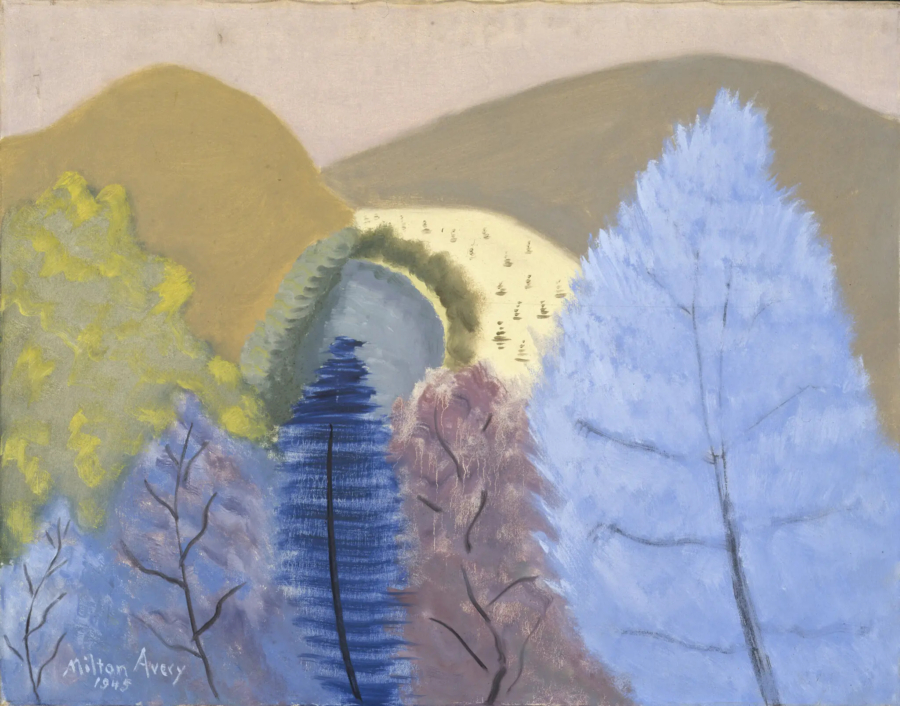September 14, 2016
Download as PDF
View on The Boston Globe

Milton Avery’s “Blue Trees” (1945) at the Wadsworth Atheneum Museum of Art in Hartford, Conn., the first retrospective exhibition of this American modernist painter in the United States in 40 years. Credit: Milton Avery Trust Artists Rights Society (ARS), NY
BENNINGTON, Vt. — In the works of Milton Avery (1885-1965), color is a bittersweet and secretive affair. Very adult. Experiencing the Avery effect is not exactly the equivalent of having an illicit fling, but somewhere in the wings you do hear a rustle of curtains, a clinking of ice, a sly, flirtatious joke.
“Milton Avery’s Vermont,” a terrific show at the Bennington Museum in Vermont, draws us into this great American artist’s singular color world. At the same time, it tethers us tightly to where we are: Vermont. The exhibition brings together, for the first time, dozens of the paintings, watercolors, and drawings Avery made on family visits to the West River Valley region of Vermont between 1935 and 1943.
It’s a crowded show — more of a muster of available works than a choice selection. But it’s richly rewarding. The colors here aren’t quite as vivid as in Avery’s better-known work of the 1950s, when he emerged as the most significant figure bridging the School of Paris modernism of Matisse and Bonnard and the New York School abstraction of Mark Rothko and Helen Frankenthaler; nor are Avery’s shapes quite as flat or eccentrically free-floating as they later became.
But they are fresh, fresh, fresh. And the many midsize watercolors depicting trees, fields, ponds, and fences — all with a vigor and immediacy sometimes missing from Avery’s more deliberately distilled oils — make the show pulse and throb like chorusing crickets.
You can’t really give Avery’s colors accurate names. That’s because, unlike Van Gogh, Miro, or Calder, who loved primary colors and cultivated childlike ways of seeing, Avery favored grown-up, indeterminate hues. They feel like correlatives for grown-up emotions.
Words like “happy,” “sad,” and “angry” may accurately describe a child’s interior life. But they don’t apply quite so straightforwardly in adulthood. It’s the same with Avery and his colors.
If bright, childlike patches of red, yellow, or blue do occasionally appear in his paintings, they’re almost always couched in affectionate irony, like a cowbell in a Mahler symphony. They’re enveloped in lush mauves, sharp chartreuses, and quizzical grays, warmed here with pale yellow, chilled there with forest green.
If Avery’s unique color sense is somewhat muted in these Vermont works, it’s partly because Vermont — in the summer, anyway — tends to be chromatically uniform. (It’s there in the Francophone name — “Vermont”: green mountain.) Avery was often there in the resplendent fall as well as the summer. But on his first visit, in the summer of 1935, it rained continually for three weeks. When it stopped, everything was so relentlessly and oppressively green that he wanted to leave.
Almost all the Vermont works — both paintings and watercolors — have an immediacy that suggests direct observation, and a fair amount of painting en plein air. But most were also worked up back in the studio. For this reason, and because the Averys did not spend summers only in Vermont in those years, it is hard to be certain about which works were painted here and which elsewhere.
But curator Jamie Franklin has done an excellent job dispelling most doubts. And it is wonderful to get a sense of the family on vacation together in such paintings as “Sketchers on the Rock,” “Spring,” and “The Picnic, Vermont.” The watercolors, in particular, tend to share arcing rhythms that, like the late, great landscapes of Rubens, emphasize rounded hills and the curvature of the earth.
They are made livelier by Avery’s variations in focus (some marks are staccato, others slurred) and hatching — all part of his attempts to evoke the different textures of the gorgeously scrappy, partially cultivated local landscape.
There are some charming curiosities — a “Self-Portrait” from 1943, for instance, and the aforementioned “Sketchers on the Rock,” which is a marvel of strong shapes and weirdly seductive color relations.
But the masterpiece here is undoubtedly “Blue Trees.” It was painted in 1945, and based on a watercolor he had made five years earlier in Jamaica, Vt. It has the feel of an enchanted distillation, a dream-like memory of a cherished place. The lines and patterns are pared right back. Avery divides the canvas into about a dozen flat shapes (it feels like fewer), each a different hue.
It is pointless to try to explain the actions of one, two, or even three of these unorthodox hues (Franklin aptly describes the trees of the title as “pale periwinkle blue and smoky lavender”), because each one breathes its specific emanation on all the others, and the effect is immediate and entire.
Avery ranks in my mind with his friend Marsden Hartley as one of the most original and convincing of midcentury American moderns. The reason he is not as well-known as the slightly younger heroes of postwar art — Rothko (whom he famously influenced), Jackson Pollock, or Willem de Kooning — is not just because he continued to paint recognizable imagery when so many others were turning to abstraction.
It is also simply because some people appreciate art that stretches their sensibility. The idea of being an “acquired taste” doesn’t quite cover it. Yes, it is to do with exposure — the more Avery works you see the more you may marvel. But it’s also, I think, to do with predisposition.
To love Avery, you need to be open to finding a certain kind of mystery within simplicity. You need to be intrigued by harmonies that teeter on the edge of dissonance. Oh, and yes: a certain amount of life has to have had its way with you.



